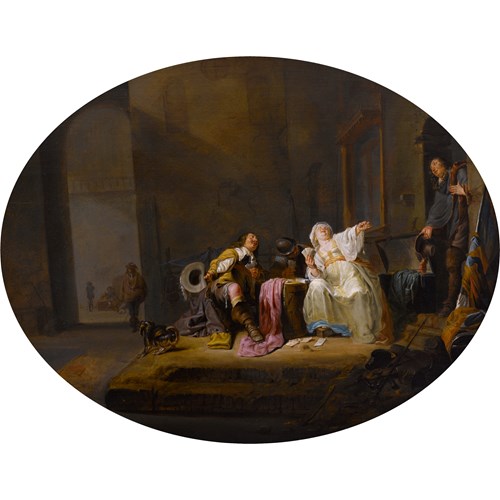Marketplace
View of the Bibi-Heybat Mosque, Baku
Olaf Viggo Peter Langer
View of the Bibi-Heybat Mosque, Baku
Date 1911
Period 20th century
Origin Germany, Denmark
Medium Oil on canvas
Dimension 71 x 87 cm (28 x 34¹/₄ inches)
In the present work Olaf Viggo Peter Langer has captured the beauty, grandeur and exoticism of one of the world’s most historic mosques. The stone of the squat structure pulsates under the fierce Azerbaijani heat and only a handful of figures have braved the sun. Langer has given over a large portion of the canvas to the sky, painted in a vivid shade of blue, with only a few wisps of cloud, and under it the ground is glaringly bright. The work demonstrates a clear fascination with what would have been an alien climate to Langer, as well as his desire to record one of Baku’s most important monuments.
The Bibi-Heybat Mosque was built in the thirteenth century to mark the tomb of Ukeyma Khanum, who, according to an inscription there was ‘a descendant of the Prophet Muhammad, the granddaughter of the sixth Imam Ja’far al-Sadiq, the daughter of the Seventh Imam Musei Kazym, sister of the eighth Imam Riza’. Ukeyma Khanum’s family had fled Baghdad in the seventh century due to persecution. She arrived in Baku and, not wanting to attract attention settled on the shores of the Caspian Sea, leading the life of a holy woman. After her death the village of Shikovo grew up around her tomb, and the site was declared a pir, or holy place.¹ Over the centuries it became one of the spiritual centres for Muslims of the region and was one of Azerbaijan’s major monuments to Islamic architecture. However, in 1930 the mosque was destroyed, as part of the Soviet anti-religious campaign, although it has now been rebuilt. As a result the present work is a valuable record of the mosque in its original form.
Langer was born in Germany to Danish parents and undertook his artistic training in Copenhagen, including a spell as a pupil of Carl Bloch (1834-1890). The majority of Langer’s works are relatively traditional landscapes depicting the beauty of the Danish countryside, particularly forest scenes notable for the handling of colour and light. He travelled on several occasions, including to the Balkans and the Caucasus in 1911, when the present work was painted, and examples from this period are especially rare. Another example from this trip is Oil Fields in Baku, and although the subject matter of the paintings is very different, they both demonstrate Langer’s ability to capture the intense heat and atmosphere of his scenes. Langer was a member of the Royal Academy of Art, and was appointed as a painter to the royal court, testament to his place as one of the leading Danish painters of the period.
1 See Azad Sharifov, ‘Legend of the Bibi-Heybat Mosque’ in Azerbaijan International (Autumn, 1998), pp.34-25.
The Bibi-Heybat Mosque was built in the thirteenth century to mark the tomb of Ukeyma Khanum, who, according to an inscription there was ‘a descendant of the Prophet Muhammad, the granddaughter of the sixth Imam Ja’far al-Sadiq, the daughter of the Seventh Imam Musei Kazym, sister of the eighth Imam Riza’. Ukeyma Khanum’s family had fled Baghdad in the seventh century due to persecution. She arrived in Baku and, not wanting to attract attention settled on the shores of the Caspian Sea, leading the life of a holy woman. After her death the village of Shikovo grew up around her tomb, and the site was declared a pir, or holy place.¹ Over the centuries it became one of the spiritual centres for Muslims of the region and was one of Azerbaijan’s major monuments to Islamic architecture. However, in 1930 the mosque was destroyed, as part of the Soviet anti-religious campaign, although it has now been rebuilt. As a result the present work is a valuable record of the mosque in its original form.
Langer was born in Germany to Danish parents and undertook his artistic training in Copenhagen, including a spell as a pupil of Carl Bloch (1834-1890). The majority of Langer’s works are relatively traditional landscapes depicting the beauty of the Danish countryside, particularly forest scenes notable for the handling of colour and light. He travelled on several occasions, including to the Balkans and the Caucasus in 1911, when the present work was painted, and examples from this period are especially rare. Another example from this trip is Oil Fields in Baku, and although the subject matter of the paintings is very different, they both demonstrate Langer’s ability to capture the intense heat and atmosphere of his scenes. Langer was a member of the Royal Academy of Art, and was appointed as a painter to the royal court, testament to his place as one of the leading Danish painters of the period.
1 See Azad Sharifov, ‘Legend of the Bibi-Heybat Mosque’ in Azerbaijan International (Autumn, 1998), pp.34-25.
Date: 1911
Period: 20th century
Origin: Germany, Denmark
Medium: Oil on canvas
Signature: Signed, inscribed and dated 'Viggo LANGER. 1911./ Shichowa' (lower right).
Dimension: 71 x 87 cm (28 x 34¹/₄ inches)
More artworks from the Gallery









